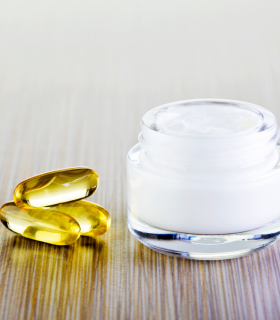Tretinoin: One Molecule, Two Very Different Missions
When most people hear the name “tretinoin,” they think of skincare: smoother texture, fewer breakouts, and that elusive youthful glow. But tretinoin has another, lesser-known identity. In a very different context—and in a very different form—it’s used to treat a rare form of cancer: acute promyelocytic leukemia (APL). How can the same active ingredient be used for something as surface-level as acne and something as life-threatening as leukemia?
This blog breaks down the key differences between tretinoin topical (used for acne and skin aging) and tretinoin oral (used for leukemia), how they work, and what unites their mechanisms despite vastly different uses.
Tretinoin Topical: The Skincare Powerhouse
What it’s used for:
-
Acne vulgaris
-
Fine wrinkles and sun damage
-
Hyperpigmentation
-
Rough skin texture
How it works:
Topical tretinoin is a derivative of vitamin A (retinoic acid) and is part of a class of compounds called retinoids. When applied to the skin, it binds to retinoic acid receptors (RARs) in skin cells, influencing how those cells grow, differentiate, and die.
Specifically:
-
It increases skin cell turnover, preventing the formation of comedones (clogged pores).
-
It reduces inflammation, a key component in acne.
-
It stimulates collagen production, making it effective for fine lines and photoaging.
-
It helps fade dark spots by speeding up the replacement of pigmented skin cells.
Patients typically see initial irritation (dryness, redness, peeling) as their skin adjusts, but over time, the benefits become apparent with more even tone and smoother texture.
Tretinoin Oral: A Lifesaving Agent in Acute Promyelocytic Leukemia
What it’s used for:
-
Acute promyelocytic leukemia (APL), a subtype of acute myeloid leukemia
How it works:
In APL, a specific genetic abnormality causes white blood cells (specifically promyelocytes) to get stuck in an immature, non-functional state. These defective cells build up, crowding out healthy blood cells and increasing the risk of life-threatening bleeding and infections.
Oral tretinoin (also called all-trans retinoic acid, or ATRA) is used as a differentiation therapy. Instead of killing cancer cells like chemotherapy does, tretinoin forces the immature leukemic cells to mature into functional white blood cells.
Mechanism of action:
-
It binds to mutated RAR-α receptors involved in the PML-RARA fusion gene (a hallmark of APL).
-
This restores normal gene transcription and allows leukemic promyelocytes to differentiate into mature granulocytes, which can then function normally and eventually die naturally.
Oral tretinoin is usually combined with arsenic trioxide or chemotherapy to improve outcomes and reduce relapse.
What Do These Uses Have in Common?
At first glance, tretinoin’s skincare use and its role in leukemia treatment seem worlds apart. But they both share a common biological principle:
Tretinoin modifies gene expression by activating nuclear retinoic acid receptors (RARs).
Whether it’s promoting healthy skin cell turnover or forcing cancerous cells to differentiate, tretinoin works at a cellular level by influencing how DNA is read and how cells grow and mature.
This ability to regulate cell differentiation and proliferation is what makes tretinoin so versatile.
Why Does the Route of Administration Matter?
-
Topical tretinoin stays primarily on the surface of the skin, acting locally. Systemic absorption is minimal, which is why it’s suitable for long-term skin use.
-
Oral tretinoin, on the other hand, circulates throughout the body and reaches the bone marrow, where it can act on blood cells involved in APL.
This difference in delivery is essential. You wouldn’t treat leukemia with a cream, nor would you take oral tretinoin to fight acne—it would be dangerous and unnecessary.
Final Thoughts: A Dual-Purpose Molecule
Tretinoin is a powerful reminder that biology doesn’t always follow rigid categories. A compound designed to regulate cellular growth can treat both blackheads and blood cancer—depending on how, where, and why it’s used.
Whether you’re applying a pea-sized amount to your cheek or swallowing a capsule during cancer therapy, tretinoin is an example of how deeply cellular signaling and gene expression influence health. And with proper use and oversight, it’s a tool that can both clear skin and save lives.
Need access to tretinoin for skin or leukemia treatment?
If you’re in the U.S. and looking for help with copay assistance, insurance navigation, or specialty pharmacy support, QuickRx can help. They offer personalized guidance and nationwide shipping to make sure patients get the care they need—fast and afford
Tretinoin Topical – Full List of Side Effects
Common Side Effects (Usually mild to moderate and may lessen over time)
-
Dryness and peeling of the skin
-
Redness (erythema)
-
Burning or stinging sensation
-
Skin irritation
-
Itching (pruritus)
-
Scaling or flaking
-
Sensitivity to sunlight (photosensitivity)
-
Temporary worsening of acne (purging effect)
-
Discoloration or lightening of treated skin
-
Warmth or tingling at the application site
Less Common Side Effects
-
Swelling at the site of application
-
Blistering or crusting
-
Skin rash
-
Change in skin pigmentation (hypopigmentation or hyperpigmentation)
-
Exfoliative dermatitis
-
Eczema-like reaction
-
Severe dryness or cracking
-
Conjunctivitis (eye irritation if contact occurs)
-
Cold sores or reactivation of herpes simplex virus
Serious (but rare) Side Effects
-
Severe allergic reactions (rash, hives, swelling of lips/face/tongue, difficulty breathing)
-
Severe skin reactions (intense inflammation or pain)
-
Excessive sensitivity to sunlight resulting in severe sunburn
Important Notes:
-
Avoid other irritating skincare products (like alpha hydroxy acids, benzoyl peroxide, or alcohol-based toners) unless directed by your doctor.
-
Use of sunscreen is strongly advised during treatment due to increased photosensitivity.
Tretinoin Oral (All-Trans Retinoic Acid, ATRA) – Full List of Side Effects
Tretinoin oral is used primarily for acute promyelocytic leukemia (APL) and has a very different and more serious side effect profile due to its systemic effects.
Common Side Effects
-
Headache
-
Fever
-
Fatigue
-
Dry skin or lips
-
Dry mouth
-
Bone pain
-
Joint pain (arthralgia)
-
Mouth sores (stomatitis)
-
Nausea and vomiting
-
Constipation or diarrhea
-
Increased sweating
-
Rash
-
Hair thinning or hair loss (alopecia)
-
Swelling of hands or feet
-
Dizziness
Serious Side Effects
-
Differentiation Syndrome (also called Retinoic Acid Syndrome):
Occurs in up to 25% of patients and can be life-threatening
Symptoms include:-
Fever
-
Shortness of breath
-
Rapid weight gain
-
Edema (especially in lungs or chest)
-
Low blood pressure
-
Renal or hepatic dysfunction
Requires immediate corticosteroid treatment.
-
-
Liver toxicity:
-
Elevated liver enzymes (AST, ALT)
-
Jaundice
-
Hepatitis
-
-
Increased cholesterol or triglyceride levels
-
Increased white blood cell count (leukocytosis), which can increase risk of differentiation syndrome
-
Severe abdominal pain or pancreatitis
-
Seizures
-
Visual disturbances (blurred vision, papilledema, optic neuritis)
-
Hearing impairment
-
Thromboembolic events (stroke, deep vein thrombosis)
Reproductive and Pregnancy Risks
-
Highly teratogenic – causes severe birth defects if used during pregnancy
-
Women of childbearing potential must use effective contraception before, during, and after treatment
Final Notes
-
Tretinoin topical is primarily a cosmetic or dermatologic therapy, and its side effects are mostly local to the skin.
-
Tretinoin oral is a systemic medication for a life-threatening cancer, and its side effects can affect multiple organs and body systems.
If you or a loved one are starting on tretinoin oral for APL, it’s essential to have close monitoring by a hematologist/oncologist. If you’re using tretinoin topical, regular check-ins with your dermatologist can help manage any irritation and adjust your routine for best results.
For those in the U.S. needing help affording either form, QuickRx Specialty Pharmacy can assist with insurance, copay assistance, and specialty care coordination.


